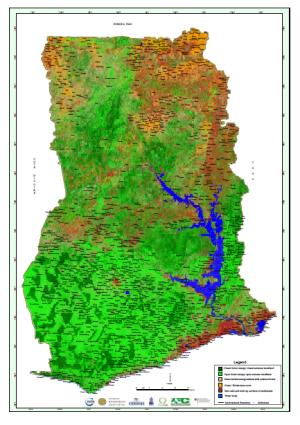Going Granular in Ghana

PROFOR first supported the mapping of landscape restoration opportunities at the global level (see the 2-billion hectare map (pdf) published by World Resources Insitute). Then kick-started similar work at the national level, starting with Ghana.
We recently spoke to one of this ongoing work's active proponents, Foster Mensah, Executive Director of the Centre for Remote Sensing and Geographic Information Services at the University of Ghana, about the different things that happen when you go from a planetary map to a finer-grained assessment.
He had several interesting observations:
-- Social processes and sensitivities matter much more at the national level. That's why the work began with a mapping of the stakeholders and governance and regulatory issues surrounding land. It was key to get stakeholders on board.
--The careful, participatory process is helping expand the horizon of the forestry department from its traditional focus on timber exploitation in forestry reserves, to understanding the degradation taking place outside forest reserves, where activities such as subsistence farming and slash and burn are taking a toll on the landscape.
--The mapping work is exposing stakeholders to the fact that trees may be gone in 15-20 years if nobody intervenes through restoration efforts. Mapping is really advocacy work, making policy makers aware of where Ghana stands today.
--The availability of detailed data is very problematic. South Dakota State University has provided crucial help with satellite imagery (selection and processing of recent Landsat images into a seamless and cloud free mosaic).
Take a look at the map below. It provides a detailed and current picture of Ghana’s land cover – something that was lacking. The project is using it to stimulate and underpin a stakeholder consultation process, and to record its results. But the map will find many other uses as well.
Map: Landcover Classification for Restoration Opportunity Assessment -- Download high-resolution PDF of the map (25 MB).

Photo: Stakeholder consultation in Kumasi, Ghana on 19 October 2011. Photo by Lars Laestadius/WRI.

Each group was asked to mark areas on the map with similar needs and opportunities for restoration. Each area was then described in writing, using a standardized form. Participants engaged passionately in the discussions.








